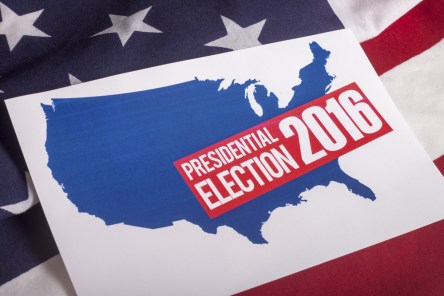Voter registration and polling facilities are a hotbed of activity this fall. With slight additions to your active or vacant real estate property, you can benefit from the buzz. When it comes to transforming a property into a voter registration or polling center, nowhere has done it up like the hotels of Los Angeles. Several news outlets reported on luxury voting facilities popping up across the city. Among them is Luxe Hotel Sunset Boulevard. The hotel offered valet parking to make arrivals and departures easier for voters. Once inside, the soothing melodies of a harpist took the edge off of the commute. The elegant ambiance undoubtedly made the lamb chops and Chinese chicken salad taste even better. Those treats appeased voters while they waited in line. On their way home, voters picked up their “I voted” stickers at the dessert table loaded with delicacies. The stunning property (pictured, right) made a mark on the minds of guests. Though the voters live locally, the social exposure makes the hotel a forerunning for voters’ future guests. Tim Miklaucic has voted at the Luxe Hotel twice now. “It’s unbelievable. It looks like a Beverly Hills spa resort,” he says. “You can’t even compare other polling places.” If you have a potential site, perhaps a vacant piece of real estate or an interesting space at an active site, there are companies that can transform it into a one-of-a-kind experience. Made in Lower East Side and Space in the Raw transform available real estate into satisfying, short-term commitments. Such companies facilitate permits, licenses, vendor contracts, event management, security—everything needed to host an event from start to finish. Though sites like the Luxe hotel have their own appeal, the presence of vendors is what sets the event apart. From musicians,...
Election Hack
Voting Security
With the presidential election only a few weeks away, questions swirl about the vulnerability of electronic voting machines. Today’s voting systems run the gamut from punch cards to touchscreens. This November, three-quarters of U.S. voters will cast a paper ballot, but the other 25% are triggering concern. As electronic voting machines get older and less secure, the question becomes: just how safe is our vote? Over at Wired, Brian Barrett investigates the vulnerabilities of America’s electronic voting machines. Though he makes sure to emphasize there’s “no evidence of direct voting machine interference to date,” he concedes the research is grim. Susceptibility to malware and denial of service attacks has repeatedly been demonstrated. In some cases, compromising an electronic voting machine could be as easy as jumping onto an unsecured Wi-Fi network. Just last year Virginia decertified 3000 WINVote touchscreen voting machines when serious security problems were exposed, including “a poorly secured Wi-Fi feature for tallying votes.” At the time, Jeremy Epstein, a computer scientist with SRI International, noted, ““anyone with even a modicum of training could have succeeded,” including someone within a half-mile of a polling pace outfitted with “a rudimentary antenna built using a Pringles can.” Hacking the Vote Aging operating systems provide the biggest opportunity for would-be hackers. As Barrett explains, most electronic voting machines use some variation of Windows XP, which hasn’t received a security patch in over two years. Unfortunately, most of the voting computers are at least a decade old, and just not equipped to deal with a sophisticated attack. “People weren’t thinking about voting system security or all the additional challenges that come with electronic voting systems,” Brennan Center’s Lawrence Norden tells Wired. “Moving to electronic voting systems solved a lot of problems, but created a lot of...


